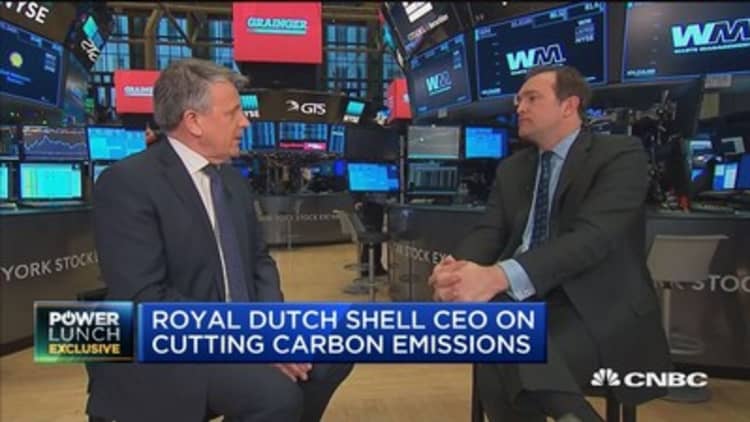
European oil giant Royal Dutch Shell wants to play a major role in combating climate change in the coming decades, CEO Ben van Beurden told CNBC on Wednesday.
Shell announced on Tuesday that it will aim to cut its carbon footprint by 20 percent by 2035 and halve its CO2 emissions by 2050. That is a lofty goal for a company that counts itself among the largest oil companies in the world.
The Anglo-Dutch company will also start disclosing how much carbon is emitted from the energy products it sells into the market. Currently, Shell reports on carbon emitted from its own operations, but does not release estimates that measure how much its business is contributing to global emissions.
"Our view is if society needs to tackle the dual challenge of climate change but also accommodating higher demand for energy — as of course the energy poor need to get access to energy as well — we have to reduce the carbon footprint of the energy system as a society to a net zero level," van Beurden said in an interview that aired on CNBC's "Power Lunch."
"That means by 2050, we have to halve the carbon footprint," he said.
Asked how specifically an oil company of Shell's scale can so significantly cut carbon emissions, van Beurden said Shell will become more efficient and add more biofuels and renewable power into its business mix. It will also invest in areas like carbon capture and storage, an emerging technology that scrubs greenhouse gases from emissions and stores them underground, according to van Beurden.

Shell's fossil fuel business dwarfs its clean energy operations today. The $25 billion to $30 billion Shell plans to spend each year will mostly go toward developing deepwater and onshore oil and gas and processing liquefied natural gas and chemicals.
Meanwhile, Shell plans to increase its spending on its clean-tech focused New Energies segment to $1 billion to $2 billion a year through 2020.
It formed the unit in 2016 to develop clean energy operations that complement its legacy fossil fuels business. The New Energies segment produces biofuels like corn-derived ethanol and hydrogen fuel. It is also piloting projects to power some of its legacy operations with solar panels.
Shell entered the wind energy business in 2001 and now operates six wind farms in the United States and Europe, according to its website. It is part of a consortium that will build two offshore farms in the Netherlands designed to generate enough energy to power 825,000 Dutch homes.
Shell's big push into natural gas could also help offset its carbon emissions.
Natural gas emits about half as much carbon as coal when it's burned. It also beats diesel, heating oil and gasoline when it comes to CO2 emissions, the primary contributor to global warming.
"We are not just an oil company," van Beurden said. "If anything we are more a gas and oil company, and on top of it, of course, we are a much broader energy company, as well."
Shell is the biggest independent producer of liquefied natural gas, or natural gas cooled to liquid form, which makes it easier to ship around the world. The company has been piloting ways to expand the use of LNG, including by using it to power sea-faring ships and road vehicles.


